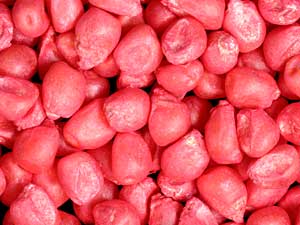|
Audio
Photos
More from MPR
Resources
Your Voice
|
A new type of corn
April 25, 2003
Farmer's love affair with genetically-modified crops is growing. This spring, for the first time, farmers can plant corn that fights off a major insect pest -- the corn rootworm. The seed was developed by Monsanto, one of the largest distributors of genetically-modified crops.
Lakefield, Minn. — Seed corn is becoming so high tech it doesn't even look like corn. It's pink. The new color is from a chemical shield encapsulating the golden kernels. Keith Buresch says the coating protects the seed from insects and disease during its first weeks in the ground.
 | |||
"The seed is the biggest decision a farmer makes," says Buresch.
Buresch runs a seed supply business on his farm near Lakefield, in southwest Minnesota. He says area farmers are interested in the new Monsanto corn. It manufactures a protein deadly to corn rootworms. He says rootworms cause $1 billion in damage each year in the U.S.
"I would say in my trade area, it's our biggest problem in corn production," says Buresch.
That's because the rootworm has shown an unnerving ability to overcome farmers' best efforts to beat it. The rootworm has built up resistance to many chemical treatments. Even more impressive are the lifestyle changes the insect has made.
 | |||
One of the most effective tools farmers have is to rotate their crops. Most plant corn one year, soybeans the next in the same field. Rootworms can't eat soybean plants, so they die soon after hatching. But entomologist Wade French, who has studied the rootworm for years, says the pest adapted to the strategy.
"Some of the eggs would undergo two year over-wintering, or what's called a diapause stage in their life," says French. "And then they would emerge when corn was planted the following year. They would, of course, survive."
Other rootworms found a different way to adapt to crop rotation. When it's time to lay eggs, the adult rootworm beetles fly from the corn fields where they hatched to nearby soybean fields. The eggs spend the winter there before hatching the next spring, just in time for the larva to feed on corn roots.
French says it's like an arms race. When the insect catches on to the latest weapon, it's time for a new one. So what are the chances the rootworm will adapt to genetically-modified corn?
 | |||
"If there's an insect that can do it, it (rootworms) probably will," French says.
That's because genetically-modified corn doesn't kill every pest. French says the rule of thumb is that one rootworm beetle in 1,000 have a natural immunity to the inbred toxin. To prevent the population of immune rootworms from growing, farmers must take certain steps. Twenty percent of their corn must be an "old-fashioned" variety -- not genetically modified. French says it provides a refuge for the corn rootworm.
"The idea of the refuge is that any insects that evolve resistance to the toxin, will have other insects to mate with that are susceptible to the toxin," French says.
The offspring of that pairing will also be susceptible to the toxin in genetically-modified corn.
 | |||
Farmer Keith Buresch says besides killing rootworms, the new corn has another benefit. Since it produces its own toxin, farmers don't have to kill the pests by spraying insecticides.
"Insecticides are just poison. Probably no farmer likes to work with insecticide," Buresch says. "If you've ever had it go up your nose or down your throat, it's not fun."
For some farmers, reducing insecticide use is the most important reason for planting genetically-modified crops. But some farmers still oppose using the seed. They worry the crops will kill beneficial insects, or that the pollen will drift and contaminate non-GM crops.
But so far, the concerns haven't significantly slowed interest in the new seeds. Half the corn and three-quarters of the soybeans planted this year in Minnesota are expected to be a genetically-modified variety.
|
News Headlines
|
Related Subjects
|

